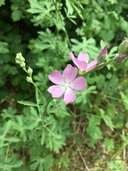Taxon Report
Sidalcea gigantea G.L. Clifton, R.E. Buck & S.R. Hillgiant checkerbloom |
 ©2018 Sierra Pacific Industries |
Taxon Summary
Sidalcea gigantea, commonly known as giant checkerbloom, is a perennial rhizomatous herb in the Malvaceae that is found only in California. It occurs within Lower montane coniferous forest, and Upper montane coniferous forest, growing at elevations from 670 to 1950 meters. Sidalcea gigantea is ranked 4.3, Plants of Limited Distribution, A Watch List; Not very threatened in California.Classification
|
Scientific Name: |
Sidalcea gigantea G.L. Clifton, R.E. Buck & S.R. Hill |
|
Common Name: |
giant checkerbloom |
| Family: | Malvaceae |
| Element Code: | PDMAL110T0 |
| USDA Plants Symbol: | SIGI |
|
Synonyms/Other Names: |
|
Ecology and Life History
| Lifeform: | perennial rhizomatous herb |
| Blooming Period: (Jan-Jun)Jul-Oct | (Jan-Jun)Jul-Oct |
| Elevation: | 670-1950 (2200-6400) |
| General Habitats: | Lower montane coniferous forest, Upper montane coniferous forest |
| Microhabitat: | Seeps |
| Microhabitat Details: | Meadows |
Conservation Status
| CA Rare Plant Rank: | 4.3 |
| Global Rank: | G3 |
|
State Rank: |
S3 |
| State List: | None |
| Fed List: | None |
| Other Status: | |
|
CRPR Changes: |
|
Occurrence Data from the CNDDB
| Total Occurrences: | 0 |
| Element Occurrence Ranks: | |
| Excellent (A) | 0 |
| Good (B) | 0 |
| Fair (C) | 0 |
| Poor (D) | 0 |
| None (X) | 0 |
| Unknown (U) | 0 |
| California Endemic: True | |
| California Counties and Islands: Name (Code) | |
| Butte (BUT), Nevada (NEV), Plumas (PLU), Shasta (SHA), Sierra (SIE), Tehama (TEH), Yuba (YUB) | |
| Quads: Name (Quad Code) | |
| American House (3912161), Berry Creek (3912164), Blue Canyon (3912036), Burney (4012186), Burney Mtn. West (4012176), Butte Meadows (4012115), Cascade (3912162), Chalk Mtn. (4012187), Challenge (3912142), Clipper Mills (3912152), Colfax (3912018), Goodyears Bar (3912058), Grass Valley (3912121), Grays Peak (4012146), Hagaman Gulch (4012157), Haskins Valley (3912172), Hatchet Mtn. Pass (4012177), Inwood (4012158), Jacks Backbone (4012166), Kimshew Point (3912184), Manton (4012147), Miller Mtn. (4012167), Pike (3912048), Pulga (3912174), Rackerby (3912143), Soapstone Hill (3912173), Stirling City (3912185), Storrie (3912183), Strawberry Valley (3912151), Viola (4012156) | |
Threat List Data from the CNDDB
| Threat List Total: | 0 | |
| EOs with Threat Listed: | Total EOs | % of EOs |
| 0 | 0 % | |
Notes
| Potentially threatened by fire suppression. Possibly threatened by logging, road construction, and road maintenance. Similar to S. asprella and S. celata. See American Journal of Botany 90(3):436-444 (2003) and Molecular Phylogenetics and Evolution 29:563-581 (2003) for taxonomic treatments, and Madroño 56(4):285-292 (2009) for original description. |
|
Threats: |
| Potentially threatened by fire suppression. Possibly threatened by logging, road construction, and road maintenance. |
|
Taxonomy: |
|
Similar to S. asprella |
Selected References
| CRPR List Addition on 2012-07-10 |
| Sidalcea gigantea account for potential Species of Conservation Concern evaluation (2022) |
Citation
California Native Plant Society, Rare Plant Program. 2025. Rare Plant Inventory (online edition, v9.5.1). Website https://www.rareplants.cnps.org [accessed 11 December 2025].